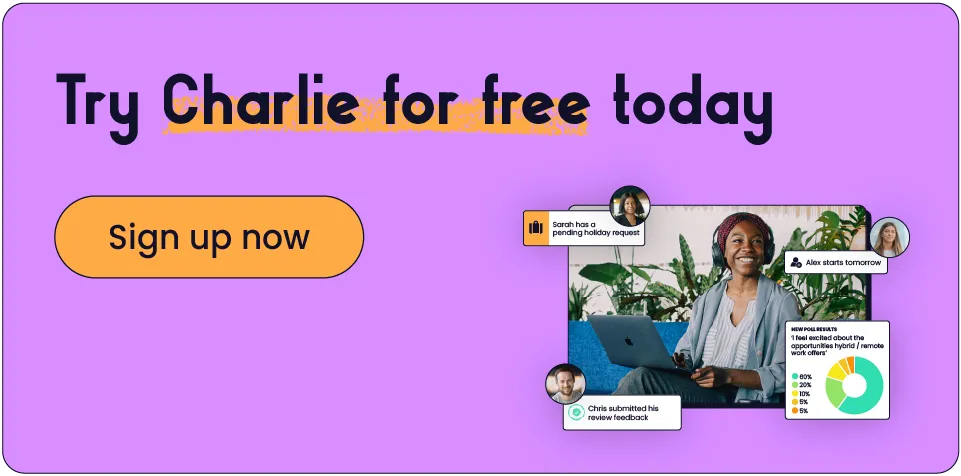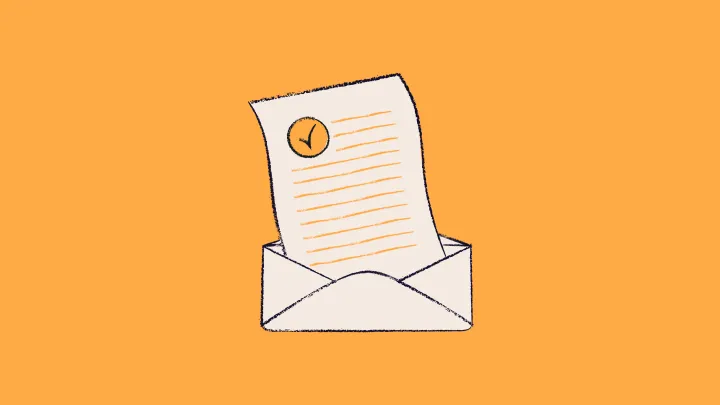How to write an employment dismissal letter (with template)

Dismissing an employee is never going to be a lot of fun, but with the right knowledge and support you’ll be able to do it fairly and without too much stress.
Knowing what you need to include in an employment dismissal letter will also help you avoid delays in the dismissal process, which is key to keeping it fair. But how do you know where to start?
Well, that’s where I come in.
As one of Charlie’s CIPD-qualified advisors, I’ve reviewed thousands of HR letters and contracts. In this guide, I’ll talk you through what a termination letter should include, and outline the legal obligations to ensure a dismissal is fair.
And if you're looking for help with a current dismissal and time is of the essence, I've included a free dismissal letter template for you to use straight away.
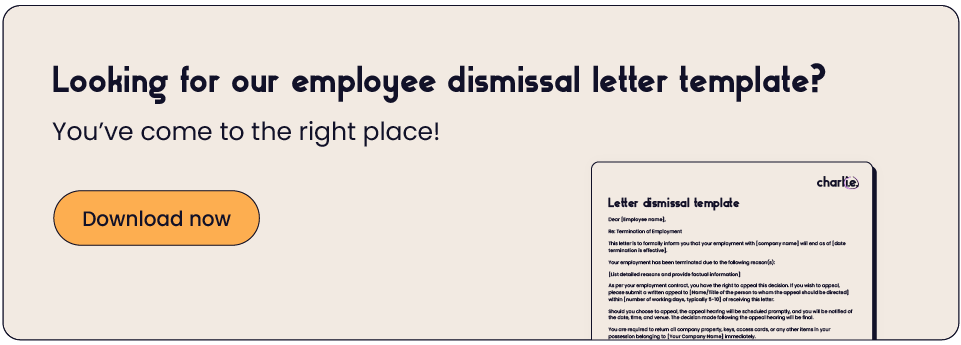
What is an employment dismissal letter?
An employment dismissal letter, also known as a termination letter or a letter of termination, formally notifies an employee of dismissal from their employment contract.
Written by the employer, a dismissal letter explains why the employment has ended and sets out the next steps for the exiting employee. A letter of termination should also confirm any outstanding pay, holiday or benefits, and how these will be processed.
As formal confirmation in writing, a termination letter helps to avoid potential miscommunication or misunderstanding around an employee’s dismissal. It also mitigates the legal risk to you as the employer, as it shows you’ve followed a fair dismissal procedure.

When should you send an employment dismissal letter?
An employment dismissal letter should be given to an employee as soon as possible.
You should seek to immediately issue a termination letter once you’ve made the decision to dismiss someone. This is because any delay could be ruled as going against fair dismissal,
Many employers hand over a dismissal letter at the dismissal meeting, also known as a termination meeting, as it helps to avoid conflict and confusion. Misunderstandings are not uncommon during verbal dismissals, so it’s important to follow everything up in writing.
How does the dismissal process work?
There are different reasons for dismissal, but it’s good practice to follow the same process regardless. As the employer, you need to show you’ve acted fairly at all times (more on this below).
Depending on the situation, some parts of the dismissal process may be more or less in-depth. For example, someone might be dismissed because:
- Their fixed term contract has come to an end
- You’ve decided to terminate their employment, for example as a result of a gross misconduct process (check out our gross misconduct dismissal letter template)
- They’ve decided to leave because you have breached their employment contract.
GOV.UK sets out the dismissal process as follows:
- Inform the employee of the issues in writing
- Hold a disciplinary meeting with the employee
- Inform the employee of the decision in writing (the employment dismissal letter)
- Give the employee the right to appeal.
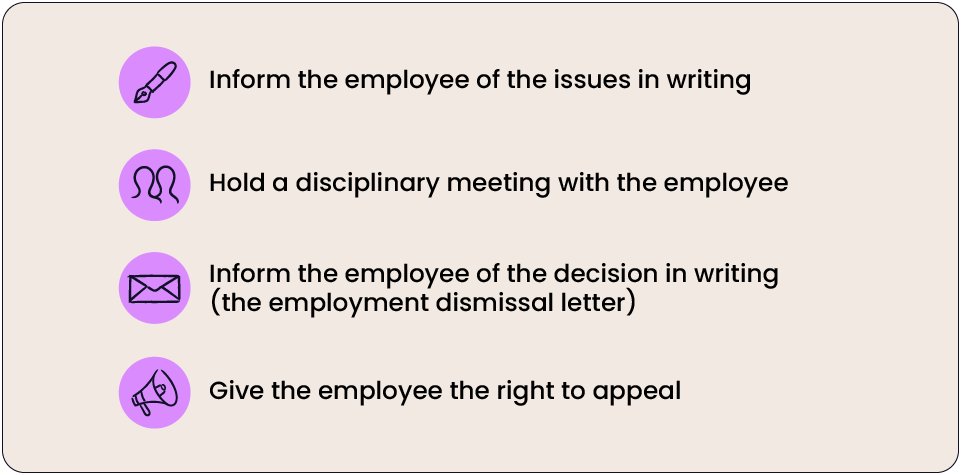
Whatever the reason, all dismissals should follow this same four-step process.
What is a fair dismissal procedure?
Following the dismissal process is vital, but a dismissal is only deemed ‘fair’ if you also act ‘reasonably’ during its entirety — even if you have a fair reason.
But as there’s no legal definition of what constitutes reasonable behaviour, acting reasonably is a pretty grey area for employers. So it’s best to err on the side of caution and always do everything by the book. You should:
- Believe that the reason for dismissal is fair
- Carry out proper investigations where appropriate
- Follow the dismissal process
- Explain why the employee is being considered for dismissal and give them a chance to respond
- Allow the employee to be accompanied at disciplinary or dismissal meetings
- Give the employee the right of appeal.
In short, as the employer, how you act throughout the dismissal process is paramount.
What are the barriers for small businesses?
There are common barriers that especially affect smaller companies when it comes to dismissing an employee:
- Legal complexity: Small businesses are unlikely to have a dedicated HR department or legal team, which makes it challenging to navigate the intricacies associated with employee dismissal.
- Fear of legal consequences: There’s a genuine worry that mistakes made during the dismissal process could have legal consequences. This fear is often compounded by a lack of resources, and causes an overly cautious or hesitant approach to dismissals.
- Emotional toll: Dismissing an employee is not just a legal process, it's a human one. It’s emotionally challenging to terminate someone's employment, especially in a close-knit work environment where personal relationships are common.
- Reputation concerns: Small businesses rely on their reputation. A poorly handled dismissal can have a negative impact on a company's image, affecting relationships with customers, partners, and the local community.
- Limited HR resources: Without dedicated HR professionals to guide them through the dismissal process, small business owners must wear multiple hats — from understanding the legal requirements to managing the communication and emotional fallout.
- Impact on morale: The close-knit nature of small teams means that one person’s departure could have a significant impact on team morale, and maintaining a positive and productive work environment is problematic.
- Lack of documentation: Small businesses don't often have robust documentation processes in place. And a lack of documentation can pose big challenges when it comes to justifying a dismissal or defending against potential legal claims.
How to write an employee dismissal letter (i.e. what to include)
An employee dismissal letter should always include the following information:
- Reason for the dismissal
- Effective date of termination
- Any outstanding salary, accrued holiday entitlement, statutory entitlements, and when they’ll be paid
- Instructions for returning company property or completing final tasks.
A letter of termination should also be professional and considerate in tone.
Dismissal letter template (UK)
Dismissing an employee takes knowledge, time and, more than likely, a fair bit of stress. So to make the process a little easier for you, we’re including a free dismissal letter template with this guide.
This letter of dismissal template is designed for UK small businesses, so you can fill it out and use it as is, or edit it to better suit your company.
Dismissal letter template
Dear [Employee name],
Re : Termination of Employment
This letter is to formally inform you that your employment with [company name] will end as of [date termination is effective].
Your employment has been terminated due to the following reason(s):
[List detailed reasons and provide factual information]
As per your employment contract, you have the right to appeal this decision. If you wish to appeal, please submit a written appeal to [Name/Title of the person to whom the appeal should be directed] within [number of working days, typically 5-10] of receiving this letter.
Should you choose to appeal, the appeal hearing will be scheduled promptly, and you will be notified of the date, time, and venue. The decision made following the appeal hearing will be final.
You are required to return all company property, keys, access cards, or any other items in your possession belonging to [Your Company Name] immediately.
Your final payslip, which will include any outstanding salary, accrued holiday entitlement up to the termination date, and any statutory entitlements, will be sent to you on the next scheduled payday on [include date].
If you have any questions regarding the termination process or if you require further clarification, please do not hesitate to contact [HR Contact Person] at [HR Contact Email/Phone Number].
We wish you the best in your future endeavours.
Yours sincerely,
[Name]
[Position]
[Contact Information]
You can also download the above template as a PDF for free:
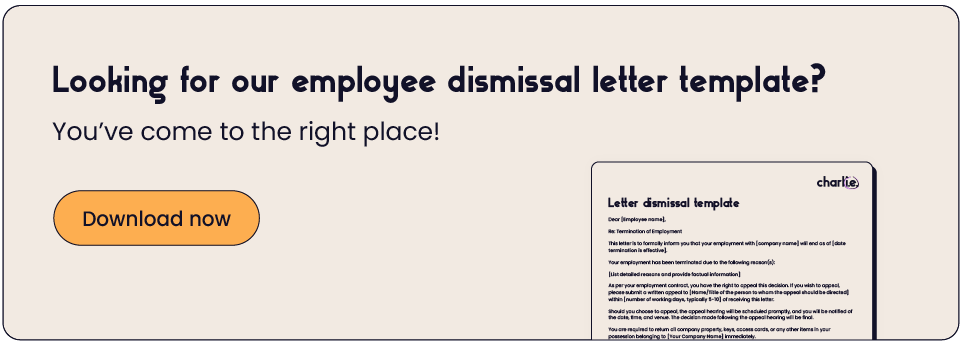
Head to our HR templates hub for more.
How Charlie can help you further with employee dismissals
As a fellow small business, sharing our knowledge and experience is at the core of what we do at Charlie. As is providing expert HR advice and easy-to-use HR software.
If you’re looking for more support with employee dismissals, or improving your HR in general, then we’d love to help.
We created our HR Advice service to support small businesses who don’t have their own HR teams. Through it, you access anytime, expert HR advice via chat, phone or email.
- With Charlie’s HR Advice you get access to a dedicated, CIPD-qualified HR advisor who will help you manage any kind of employee issue
- Your advisor will guide you to the dismissal process making sure you treat everyone fairly and comply with the latest legislation.
Our HR software will also help you navigate employee dismissals far more easily:
With Charlie, you’ll finally have one, secure place where to store all of your business and employee documents, including dismissal letters, and templates.
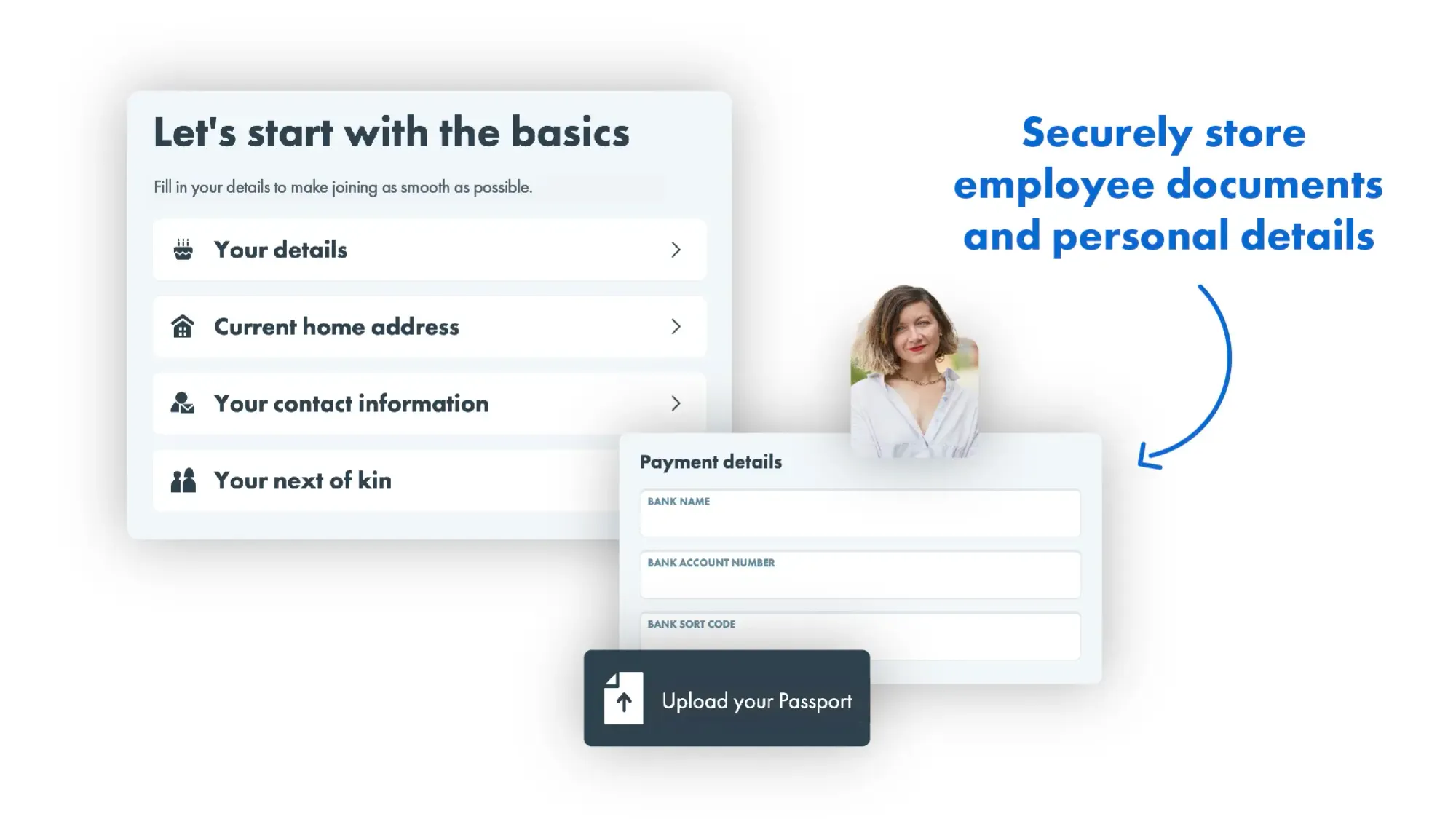
And you can try our software out for free!
Don’t dismiss the idea of affordable and expert HR support — Charlie’s made for businesses just like yours.
